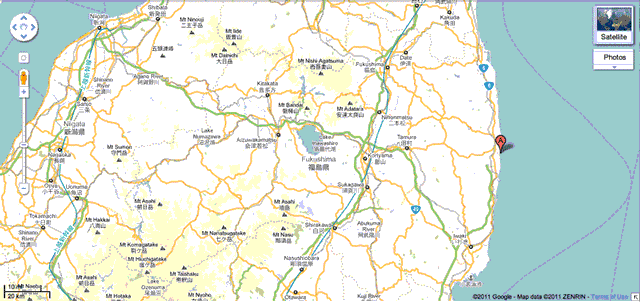April 21, 2011
How Does Radiation Travel?

After writing about the Fukushima Ring, and after reading articles like this, I must acknowledge the human cost of such an action as is ring building::
Chief Cabinet Secretary Yukio Edano told a news conference that from midnight on Thursday, people could only go into the zone under government supervision."We will take strict legal measures against those trying to enter the area ... For residents, all I can say is I ask for their understanding so that no legal action will be taken against them."
Anyone breaking the ban can be fined up to 100,000 yen ($1,200) or be detained by police.
TEPCO has said it may take the rest of the year or longer to bring the plant under control.
More than 130,000 people are living in school gymnasiums and other shelters more than a month after the March 11 quake and tsunami that left some 28,000 dead or missing.
"HOW DO YOU THINK WE FEEL?"
"Are you leaving?" one man shouted as Kan and his entourage headed for the door at a Fukushima evacuation center. "We are evacuees. Are you just going to ignore us?"
Kan turned back and apologized, only to be berated again.
"You should bring cabinet ministers here and let them try living here themselves. How do you think we feel? We want you to somehow get the nuclear plant under control," one woman said
As for the human cost, with rounded numbers like 28,000, it's easy to guess that the real number is larger, probably much larger. The true tragedy is the dimension of life lost in the sum total of the disaster. Displacing angst from mourning into outrage against any agency should be considered as ill considered. A great tragedy happened and the people of Japan must build our way out of it. The mindset of building is fundamentally different if not superior to the mindset of grievance. The fate of 130,000 survivors is in the balance and their welfare is an integral part of the reconstruction of the stricken area. This is, I believe, the best first priority for Japan and their friends in the worldwide community.
People who once lived next door to the plant will be displaced for certain, people living in the next closest proximity will have to see what the health effects frame the closest, safest edge of the protection zone. There might be many ways to define this, but any answer has to satisfy the need to protect people from harm.
Here's another recent article:
Katsunobu Sakurai, mayor of Minami Soma, where about half the 71,000 residents lived in areas that are now off-limits, questioned the rationale for the way the evacuation zone was decided.Zing!"It feels like some outsider who doesn't know anything about our geography sat at a desk and drew these circles," Sakurai said. "The zones have zero scientific basis. Radiation doesn't travel in neat circles. Just putting up circles around the plant is unreasonable."
I am one of those circle drawing outsiders. I hope you will note that I had at least refrained about speculating about the design aspect of the wall or sarcophagus. The actual safe zone around the nuclear plant is probably not a perfect circle, and perhaps it shouldn't be abstracted from afar, but then the mitigating aspects of a real boundary would be principally circumscribed by the geographic topography that might shield neighboring communities and not simply derived from the fact that radiation decreases in power the farther in distance it travels from its source. A quick look at the map tells me that Minami Soma has little to no such shielding from the landforms to the north along the coast. Only a rigorous scientific assessment can deliver the best answer to this question.
Meanwhile, fingers twirl a compass.
UPDATE: First, the ring shrank to 12 miles, now it might have disappeared:
Highlighting the differences between Chernobyl and Fukushima, he said people in villages close to the plant in the then Soviet Union were exposed to radioactive iodine that contaminated milk and vegetables.It will be interesting to see how close people can safely live near the site... or better, how people frame the question that will provide the answer. Posted by Dennis at April 21, 2011 2:00 PM"They inhaled first, then they ingested this iodine and this caused the problem," Weiss said. "In Fukushima, the people were evacuated before any release took place, so this is a totally different situation."
Asked what health consequences he expected from Fukushima, he said: "From what I know now, nothing, because levels are so low. In food, people are talking about levels which would give you one millisieverts per year, five millisieverts per year . . . this is nothing where we would expect major health impacts."
Leave a comment